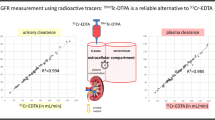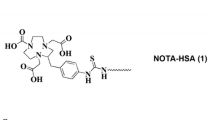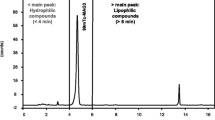Abstract
Technetium-99m labelled red blood cells (99mTc-RBCs) are far superior to 99mTc-labelled human serum albumin (99mTc-HSA) for radionuclide ventriculography, but their labelling is more complex, time consuming and risk bearing (in vitro labelling) or suffers from interference by some medications (in vivo labelling). We have now modified HSA by the introduction of mercapto groups with the purpose of preparing stable and practical 99mTc-mercaptoalbumin with long retention in the vascular system, that could replace 99mTc-RBCs. HSA was incubated with N-succinimidyl S-acetylthioacetate (SATA) or N-succinimidyl 2,3-di(S-acetylthio) propionate (SATP) to introduce a chain containing one or two protected sulfhydryl groups on some of the lysine amino groups. After purification by size-exclusion chromatography (SEC), the mercapto groups were deprotected by incubation at alkaline pH or by treatment with hydroxylamine. The reaction products were used with or without SEC purification for direct or exchange labelling experiments with 99mTc at neutral pH. SEC-HPLC was used to determine labelling yields and to isolate pure 99mTc-mercaptoalbumin. Stable 99mTc-mercaptoalbumin complexes could be formed in 90%–95% yield after coupling albumin with SATA or SATP in all molar ratios used followed by deacetylation in one of the mentioned conditions. The most favourable results were obtained after reaction of SATA or SATP with HSA in a 25: 1 ratio and deprotection with NH2OH. The stability of the resulting 99mTc-mercaptoacetyl-albumin (99mTc-MAHSA) and 99mTc-dimercaptopropionyl-albumin (99mTcDMP-HSA) and their retention in vivo in plasma of mice and rabbits are clearly higher than that of conventional 99mTc-HSA preparations. 99mTc-DMP-HSA approaches the behaviour of 125I-HSA quite well in both animal species. A preliminary study with 99mTc-DMP-HSA in a volunteer showed a retention in the vascular compartment almost identical to that of 99mTc-RBCs and clearly higher than that of a common 99mTc-HSA preparation. The results indicate that these 99mTc-mercaptoalbumins and especially 99mTc-DMP-HSA are very promising as a practical alternative to 99mTc-RBCs.
Similar content being viewed by others
References
Leitl GP, Drew HMN, Kelly ME, Alderson PO. Interference with Tc-99m labeling of red blood cells (RBCs) by RBC antibodies [abstract]. J Nucl Med 1980;21:44
Pauwels EKJ, Feitsma RIJ, Blom J. Influence of adriamycin on red blood cells labeling: a pitfall in scintigraphic blood pool imaging. Nucl Med Commun 1983;4:290–293
Seawright SJ, Maton PJ, Greenall J. Factors affecting in vivo labeling of red blood cells. J Nucl Med Technol 1983;11:95
Chilton HM, Callahan RJ, Thrall JH. Radiopharmaceuticals for cardiac imaging: myocardial infarction, perfusion, metabolism, and ventricular function (blood pool). In: Swanson DP, Chilton HM, Thrall JH, eds. Pharmaceuticals in medical imaging. New York: Macmillan Publishing Co; 1990:448
Levy WC, Cerqueira MD, Veith R, Stratton JR. Factors influencing serial measurements of cardiac volumes by count-based methods: effects of elevated catecholamines, position and exercise on technetium-99m-blood radioactivity concentration. J Nucl Med 1992;33:1324–1329
Thrall JH, Freitas JE, Swanson D, Rogers WL, Clare JM, Brown ML, Pitt B. Clinical comparison of cardiac blood pool visualization with technetium-99m-red blood cells labeled in vivo and with technetium-99m-human serum albumin. J Nucl Med 1978;19:796–803
Atkins HL, Klopper JF, Ansari AN. A comparison of Tc-99m-labeled human serum albumin and in vitro labeled red blood cells for blood pool studies. Clin Nucl Med 1980;5:166–169
Nusynowitz MI, Straw JD, Benedetto AR, Dixon RS. Blood clearance rates of technetium-99m albumin preparations: concise communication. J Nucl Med 1978;19:1142–1145
McMenamy RH, Dintzis HM, Watson F. Cyanogen bromide fragments of human serum albumin. J Biol Chem 1971;246:4744–4750
Verbruggen A. Radiopharmaceuticals: state of the art. Eur J Nucl Med 1990;17:346–364
Srivastava SC, Straub RF. Blood cell labeling with 99mTc: progress and perspectives. Semin Nucl Med 1990;20:41–51
Benary E. Über Thio-tetronsaure and Derivative. Ber Dtsch Chem Ges 1913;46:2103–2107
Duncan RJS, Weston PD, Wigglesworth R. A new reagent which may be used to introduce sulfhydryl groups into proteins, and its use in the preparation of conjugates for immunoassay. Anal Biochem 1983;132:68–73
Ondetti MA, Weisenborn FL. Substituierte Aminosäuren. Ger Offen 2,752,720 1978;21
Klotz IM, Heiney RE. Introduction of sulfhydryl groups into proteins using acetylmercaptosuccinic anhydride. Arch Biochem Biophys 1962;96:605–612
Ellman GL. A colorimetric method for determining low concentrations of mercaptans. Arch Biochem Biophys 1958;74:443–450
Ellman GL. Tissue sulfhydryl groups. Arch Biochem Biophys 1959;82:70–77
Fritzberg A, Whitney W, Kuni C, Klingensmith W. Biodistribution of 99mTc-N,N′-bis-(mercaptoacetamido)ethylenediamine. Effect of renal tubular inhibitors. Int J Nucl Med Biol 1982;9:79–82
Stroupe SD, Foster JF. Further studies of the sulfhydryl-catalyzed isomerization of bovine mercaptalbumin. Biochemistry 1973;12:3824–3830
Wallevik K. Reversible denaturation of human serum albumin by pH, temperature and guanidine hydrochloride followed by optical rotation. J Biol Chem 1973;248:2650–2655
Baidoo KE, Scheffel U, Lever SZ. 99mTc labeling of proteins: initial evaluation of a novel diaminodithiol bifunctional chelating agent. Cancer Res (Suppl) 1990;50:799s–803s
Dzhafarov ES. pH-Dependent conformational transitions of human serum albumin. Investigations by tritium labelling. Mol Biol 1991;25:1109–1113
Fritzberg AR, Kasina S, Eshima D, Johnson DL. Synthesis and biological evaluation of technetium-99m MAG3 as a hippuran replacement. J Nucl Med 1986;27:111–116
Wallovitch RC, Hill TC, Garrity ST, Cheesman EH, Burgess BA, O'Leary DH, Watson AD, Garey MV, Morgan RA, Williams SJ. Characterization of technetium-99m-L,L-ECD in non-human primates. J Nucl Med 1989;30:1892–1901
Verbruggen AM, Nosco DL, Van Nerom CG, Bormans GM, Adriaens PJ, De Roo MJ. Technetium-99m-L,L-ethylenedicysteine: a renal imaging agent. I. Labeling and evaluation in animals. J Nucl Med 1992;33:551–557
Hansen HJ, Jones AL, Grebenau R, Kunze A, Goldenberg DM. Labeling of anti-tumor antibodies and antibody fragments with Tc-99m. Cancer Treat Res 1990;51P:233–244
Goedemans WT, de Jong MTM, Ensing GJ, Panek KJ. 1-Imino-4-mercaptobutyl derivatization and 99mTc labelling of proteins. Nucl Geneesk Bull 1990;12:127–135
Author information
Authors and Affiliations
Additional information
K.A. Verbeke is a Research Assistant for the Belgian National Fund for Scientific Research
Rights and permissions
About this article
Cite this article
Verbeke, K.A., Vanbilloen, H.P., De Roo, M.J. et al. Technetium-99m mercaptoalbumin as a potential substitute for technetium-99m labelled red blood cells. Eur J Nucl Med 20, 473–482 (1993). https://doi.org/10.1007/BF00175159
Received:
Revised:
Issue Date:
DOI: https://doi.org/10.1007/BF00175159




